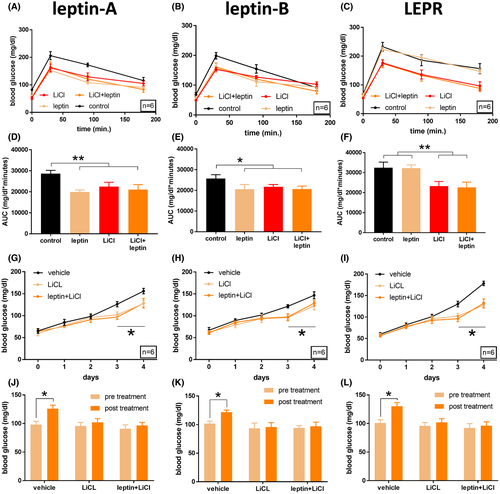
Activation of canonical Wnt signaling improves glucose tolerance in lepanz301 fish, lepbnz302 fish, and leprnz303 zebrafish. (A) Glucose tolerance of adult male lepanz301 zebrafish (n = 6). Fish were treated 10 ?M LiCl (3 h before glucose injection), 0.6 g/L of recombinant mouse leptin dissolved in Cortland salt solution (1 h before glucose injection), vehicle only, or a combination of LiCl and leptin. Following 0.5 mg/g glucose injection, blood samples were taken at 30, 90, and 180 min post-injection. (B) Same as (A), but for lepbnz302 fish. (C) Same as (A) and (B), but for leprnz303 fish. (D) Area under the curve of (A). **p < .001, one-way ANOVA. (E) Area under the curve of (B). *p < .05, one-way ANOVA. (F) Area under the curve of (C). **p < .001, one-way ANOVA. (G) Blood glucose values of adult male lepanz301 zebrafish (n = 6) over the course of a 4-day immersion in a 1% glucose solution. On the third day, fish were exposed to 10 ?M LiCl for three h before daily blood sampling. One hour before blood sampling, fish were injected intraperitoneally with 0.6 g/L of recombinant mouse leptin dissolved in Cortland salt solution, or with vehicle only. *p < .05, repeated-measures ANOVA. (H) Same as (G), but for lepbnz302 fish. *p < .05, repeated-measures ANOVA. (I) Same as (G) and (H), but for leprnz303 fish. *p < .05, repeated-measures ANOVA. (J) Blood glucose levels of (G), comparing pre-treatment (day 2) and post-treament (day 3). (K) Same as (J) but relating to (H). (L) Same as (J) and (K) but relating to (I)
|

